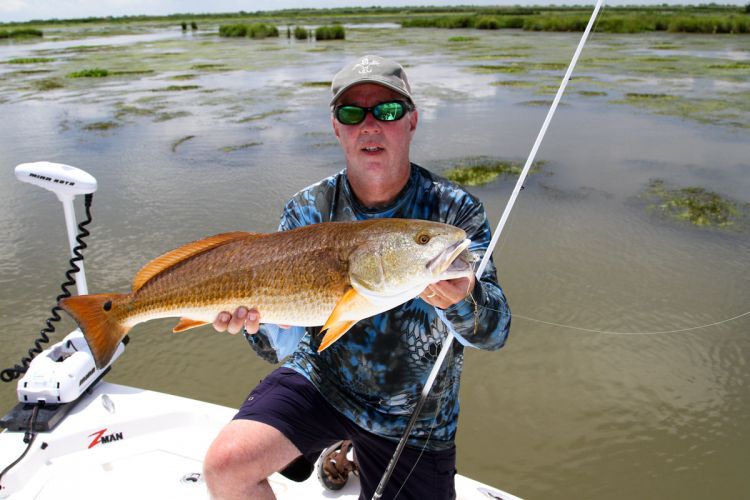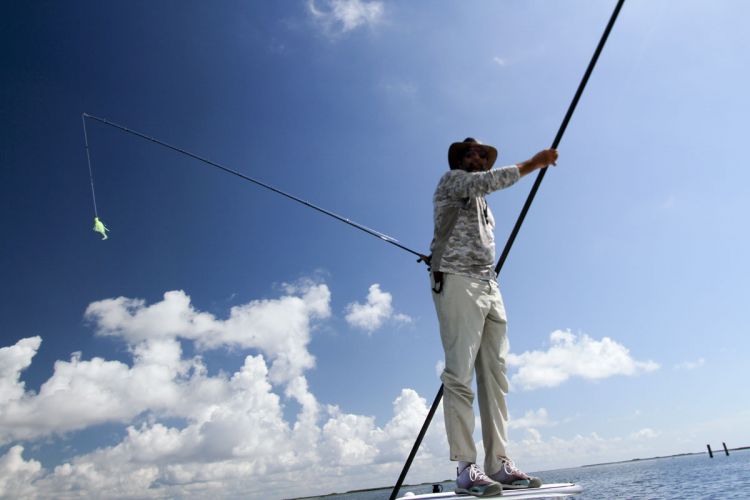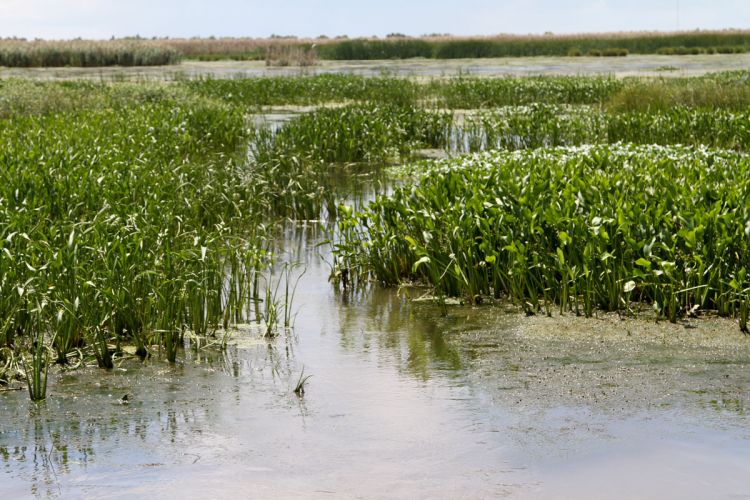 A primer for taking reds in ultra skinny water.
A primer for taking reds in ultra skinny water.
I tried to ignore the single heart-shaped cloud punctuating a pleasantly blue sky caping the spartina grass; did my best to tune out the distant thunder of a Gulf storm building to the west; and I told myself to not tarry a glance on the dozen magnum fiddler crabs waving oversized claws from their muddy perches.
Notable as they were, it wasn’t these crustaceans we sought — we were after was the one who sough them. Fate smiled and Capt. C.A. Richardson’s sharp, clear instructions guided my following motion.
“There, 1 o’clock, he’s tailing, 10 feet,” the Buras guide said from his skiff’s poling platform.
A short cast landed a foot too far right, but the follow-up was on the money. I led the fish a couple of feet, brought the Mustad Shad Jig past his face and two hops later, it was off to the races.
And that’s how sight-fishing for marsh reds typically plays out. Far more precise than blind casting and much more engaged than soaking cut baits, this is a hunt; a quest to locate a target and present a bait before the fish spots you.
Some clarity, please
If the notion of water clear enough for sight fishing sounds foreign to the Louisiana coast, just consider the insights of Capt. Ryan Lambert, proprietor at Cajun Fishing Adventures and Vanishing Paradise Advisory Council member. As he points out, the majority of the sediment is suspended, so there’s often cleaner water below.
Now, that doesn’t do a sight fisherman any good, since we’re talking about a top-down approach. But don’t fret, Lambert says the marsh equivalent of a pool skimmer creates opportunities.
“Mother Nature can filter out that sediment and that takes submerged aquatic vegetation (SAV),” he said. “You want to look for that SAV if the river is high and you have a lot of suspended sediment.
“Another scenario is when the river goes down. When it gets under 3 feet at the New Orleans gage in Carrollton, the saltwater starts backing up and you’ll find a lot of clear water around the coastline.”
Complementing the SAV, Lambert points to vast stands of Roseau cane, which also provide filtration service. All of this plant life, he said, imparts a clarifying influence that yields an influence on both sides of the tide.
“You can get around that submerged aquatic vegetation when the water is coming out of it, or you can get behind it when the water is crystal clear. That’s the secret to fishing south Louisiana.”
Noting the importance of rebuilding Delta wetlands lost to coastal erosion, Lambert points to the Mardi Gras diversion — a pass created by a levee breach during Mardi Gras 2012 — which has pumped massive amounts of land-building sediment into the coastal zone. The result has been a sight-fisherman’s dream.
“This (sediment distribution) is growing aquatic vegetation all the way out to open water,” Lambert said. “That whole area is coming back to life and that’s really going to clear up a lot of new water for us.”
And here’s the double benefit: “That aquatic vegetation acts as a nursery for juvenile fish, crabs and shrimp to grow up and avoid predation. So, the redfish constantly cruise up and down these grass lines and where there are pockets of clear water, you get schools of them.”
When sight fishing is right
Lambert will sight fish any tide stage, but he expects his best action on the outgoing. Here, the clear, filtered water falling out of the marsh brings loads of food to hungry reds in what is often a turkey shoot.
“If you get a good thoroughfare where they’re coming and going, you can just Power-Pole down and hang tight,” Lambert said. “It’s just like a parade and you just pick ‘em off when they come by you.”

Other considerations:
Sky conditions: Richardson said he does his best to avoid cloud reflections, which obscure his surface view. Summer cloud cover usually builds during the day, so afternoons generally present the most challenge.
Wind: The less the better for spotting fish, but remember; as your vision increases, so does the fish’s.
Time of Day: On planned sight-fishing trips, Lambert doesn’t leave the lodge until 7 or 8 o’clock because until the sun gets gains a little altitude, it’s too hard to spot the fish. Light penetration is key and once you reach the right angle, it’s laissez les bon temps rouler!
Best baits
For his sight-fishing efforts, Richardson likes a Z-Man Jerk Shadz Texas rigged on a Mustad Grip Pin flipping hook. This setup allows him to work the bait across the surface for a twitching topwater look, or glide it down through the water column. For a little more casting distance and accuracy he’ll also use a ¼-ounce Mustad Shad head jig with a soft plastic shad tail.
In the summer months, Lambert goes with a 3 ½- to 4-inch bait like the Z-Man Diezel Minnowz or an H&H grub-style jig, but for the cold season, he downsizes to a 2 ½-inch bait. As for bait colors, he likes a little chartreuse on the tail to match those Delta shrimp.
“I really like sight fishing them with topwater hard baits, but you can’t do that while you’re guiding because you’ll wear them,” Lambert said.
In deeper areas like canal and bayou edges, you might catch glimpses of redfish moving in and out of covering vegetation. Or, you might see fish pushing down a duck pond’s shoreline; often with their backs out of the water. These are good moments for a well-placed spinnerbait. In the duck ponds, “banging the bank” — literally hitting the muddy edges and mimicking a blue crab scurrying out of the grass creates a noisy disturbance that fits the profile your sighted fish is seeking.

Strategy points for sight fishing reds
Wait for Your window: Contrasting the blind cast routine, Lambert said he holds his fire until he has visual confirmation — even if it’s a gradual process.
“Normally, what you’ll see first is that tail going back and forth,” Lambert said. “And then, just like deer hunting where you’re looking for an ear or looking for a tail, then you make a fish out of it.
“Even in crystal clear water, you may not notice a fish until you see that tail moving and then you say ‘Ah, I see you down there.’ So, you look for any kind of movement and then you make a fish out of it.”
Peripheral vision: Even when Richardson is scanning shorelines and grass edges, he’s also watching surrounding waters for what he calls “floaters” — redfish hovering high in the scattered grass.
“You’ll see fish floating amid the hydrilla and coontail; these fish are up high, ready to eat,” he said. “I love it when you see a raft of fish floating together. It’s like throwing a cookie into a Weight Watchers meeting.”
Presentation precision: Richardson suggests a low, lobbing cast that doesn’t spook fish with either a high, waving rod motion or an obtrusive splash. To the latter point, he likes to feather his spool to slow the bait’s momentum right before touch down.
Also keen on the stealth element, Lambert said boat positioning and casting angles bear great impact on your success. Specific set up, he said, depends on your chosen technique.
“If I’m fly fishing, I’ll position the boat so the fish is at 10 o’clock, so the fly fisherman can cast with the line to the outside of the boat (assuming a right-handed angler),” he said. “If you’re throwing (lures), I like to throw what I call ‘two-by-two’ — two feet beyond the fish and two feet in front of the fish. That way you bring the bait right by the fish; you don’t want to cast right on his nose because eight times out of 10, he’s going to move away from it.
“I always like to have the bait in action, moving across the fish. Work the bait in front of him and most times, you’re going to get a hit.”
Keen on maximizing every opportunity, Richardson keeps a rod tucked in his waist band for an easy reach that’s more secure than laying a rod on the poling platform. Often, the elevated view reveals fish the angler on the bow simply can’t reach in time. Good example of how luck is the intersection of opportunity and preparation.


